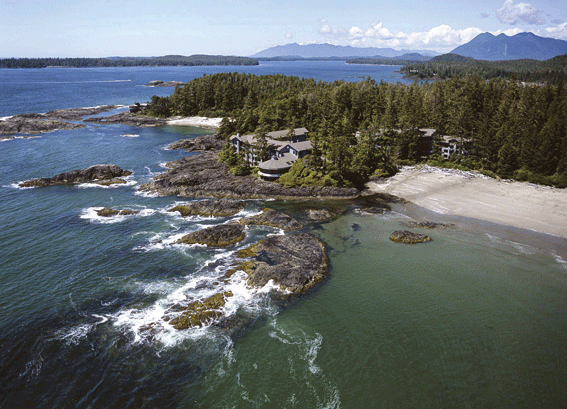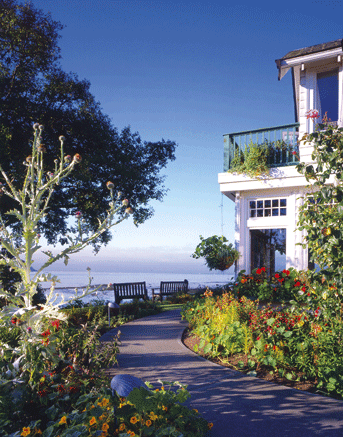
Travel
A Vancouver Island Odyssey
Vancouver Island is a temperate rain forest, covered with towering trees, especially on the western side of the spine of mountains that runs the length of the island.
By: Tom Passavant
“You’re getting Seaweed 101,” says Diane Bernard as we pick our way across the slippery tidal flats of Whiffen Spit. It’s low tide on the southwest corner of Vancouver Island, and we’re just a few yards offshore from the island’s most famous lodge and restaurant, Sooke Harbour House. My wife and I have been out here in our rain jackets for maybe 30 minutes and already Bernard, known as the Seaweed Lady, has us chewing, rubbing and learning more than we’d ever imagined about seaweed.
“Think of the ocean as a garden,” she says, her voice mingling with foghorns, barking seals and crying gulls, “and summer is the height of the growing season.” Her company, Outer Coast Seaweeds (877-713-7464; www.outercoastseaweeds.com), harvests seaweed along 43 miles of Vancouver Island’s mostly uninhabited Pacific coastline, and Bernard leads hands-on tours like the one we’re taking. As she talks, she breaks off a stem of alaria and lets us rub the clean, aloe-like gel over our skin. From tide pools she plucks sea lettuce, kombu, dulse and nori, this last one familiar to sushi lovers around the world.
The Seaweed Lady exemplifies the spirit of Vancouver Island: making the most of nature’s extravagant gifts to this island, the largest on the west coast of North America. It lies immediately above the state of Washington across the Strait of Juan de Fuca, and due west of the city of Vancouver. While the population hovers around 750,000, the people are outnumbered, if not quite surrounded, by grizzlies, black bears, wolves, cougars, eagles, moose and elk, not to mention seals and whales. The land itself is temperate rain forest, covered with towering trees, especially on the western side of the spine of mountains that runs the length of the island.

Our tour ends back up at Sooke Harbour House, itself a microcosm of island life. For the past 29 years, Sooke (250-642-3421, www.sookeharbourhouse.com, rates from $286) has been the handiwork of the couple Sinclair and Frederique Philip. Outside, it’s an unpretentious, two-story white auberge with 28 guest rooms. Inside, it’s a sophisticated enclave filled with paintings, carvings, pottery and fiber art, mostly by local artists. Sooke’s restaurant draws diners from around the globe, and for good reason: Its cuisine is unique and totally bound up with its location. Same-day fish and shellfish -- as well as seaweed -- comes from just outside the door, and virtu-ally every other growing thing, aside from the lawn, finds its way into the kitchen. One afternoon Sinclair Philip led us around the grounds (free tours are given every morning at 10:30), and we found it difficult to walk more than five paces without him plucking some leaf, flower, root or stalk and inviting us to munch away. Kiwis, lavender, figs -- over 200 edible fruits and plants thrive here.
Another example of making the most of what nature provides comes at The Butchart Gardens. It all began around 1904, when Robert and Jennie Butchart planted a handful of sweet peas and a single rose. Then the propitious climate took over and, as hobbies tend to do when the hobbyists are very wealthy, things got out of hand. Soon Jennie was casting her eyes longingly on the adjacent limestone and clay quarry, the source of her family’s considerable cement-manufacturing fortune. Fast-forward a century and Butchart is now the gar-dening equivalent of Liberace -- an extravagant show garden (as opposed to a botanical garden) whose aim is to dazzle visitors with sheer beauty and abundance. The rose and Japanese gardens are especially famous, but every tree, shrub and flower bed is worth sev-eral oohs and aahs.
The Butchart Gardens is about 15 miles north of Victoria, the island’s major city, which anchors its southern end. Though Victoria has only around 312,000 residents, it -- and not the much larger Vancouver -- is the capital of British Columbia and seat of the provincial government.
Settled in 1843, Victoria has long been regarded as a somnolent outpost of “merrie olde England.” Every day busloads of sightseers are disgorged in front of the iconic harborside Empress Hotel (250-384-8111, www. fairmont.com/empress, rates from $148), which is celebrating its centenary this year, and a picture-perfect afternoon tea is served in its Tea Lobby and Library. Seaplanes come and go in the pint-size inner harbor, which is lined with several other fine old structures, including the Provincial Legislative Buildings and the Royal British Columbia Museum. But Victoria’s got a secret: The dowager has a streak of magenta in her hair and a pierced nostril. In the handsome brick buildings around LoJo (as the Lower Johnson area has been dubbed), we found art galleries, hipster fashion bou-tiques, vegetarian restaurants, coffee shops and up-to-the-minute establishments.
After several days of exploring the island’s south end, it was time to head to the wilder north. It’s hard to drive more than a few miles up the eastern side of Vancouver Island without encountering someone who is growing grapes, making goat cheese, pressing apples into cider, baking bread from heirloom wheat or spinning wool from local sheep. The heart of this movement is in the bucolic Cowichan Val-ley, about an hour north of Victoria. We spent the night there, staying at Fairburn Farm (250-746-4637, www.fairburnfarm.bc.ca, rates from $129), which bills itself as a “culinary retreat and guesthouse.” Also a working farm, with a resident herd of water buffalo, it is home base for Italian-trained chef Mara Jernigan. Family-style meals here are legendary. One night we were very happy with a dinner that featured raspberries plucked from a bush outside the kitchen door and roast duck from just down the road.
About halfway up the island, Highway 4 heads due west, cutting across mountains and old-growth forests. As we wound through hemlock and firs, we could sense real wilderness just outside the car doors. One of the unique lures of Vancouver Island, especially around our destination, Tofino, is the number of ways you can explore the woods and water. Whale-watching, bear-watching, hiking, kayaking, beachcombing, fishing, seaplane rides, soaking in hot springs and surfing -- especially surfing -- are all popular.

The town itself, home to nearly 2,000, sits at the tip of a long, narrow peninsula with the ocean to the west and a wonderland of fjords, coves and inlets, all backed by rugged peaks to the north and east. There is a definite end-of-the-road feeling, given the battered wood buildings, working fishing boats and serious wildlife, offset by a couple of sophisticated restaurants and galleries. Tofino has lately become chic among entertainers and the filmmaking set from Vancouver, not to mention all the newly oil-rich Albertans.
South of town, beaches such as Chesterman and Long Beach are broad and beautiful. Chesterman is the setting for another island landmark, the Wickaninnish Inn (800-333-4604, www.wickinn.com, from $257). Sleek and polished, the Wick offers 75 rooms and suites and a full spa. It’s flush with hand-carved woodwork, and the dining room, The Pointe Restaurant, is the place to try local scallops or wild salmon.
We were staying at A Snug Harbour Inn (888-936-5222, rates from $188), about 20 miles south of Tofino in the hamlet of Ucluelet. The inn’s Web address says it all: www.awesomeview.com. The shipshape rooms look out on a tree-lined cove so picturesque you won-der how anyone ever manages to check out.
If this is what nature gives them up here, we’ll take it any time.